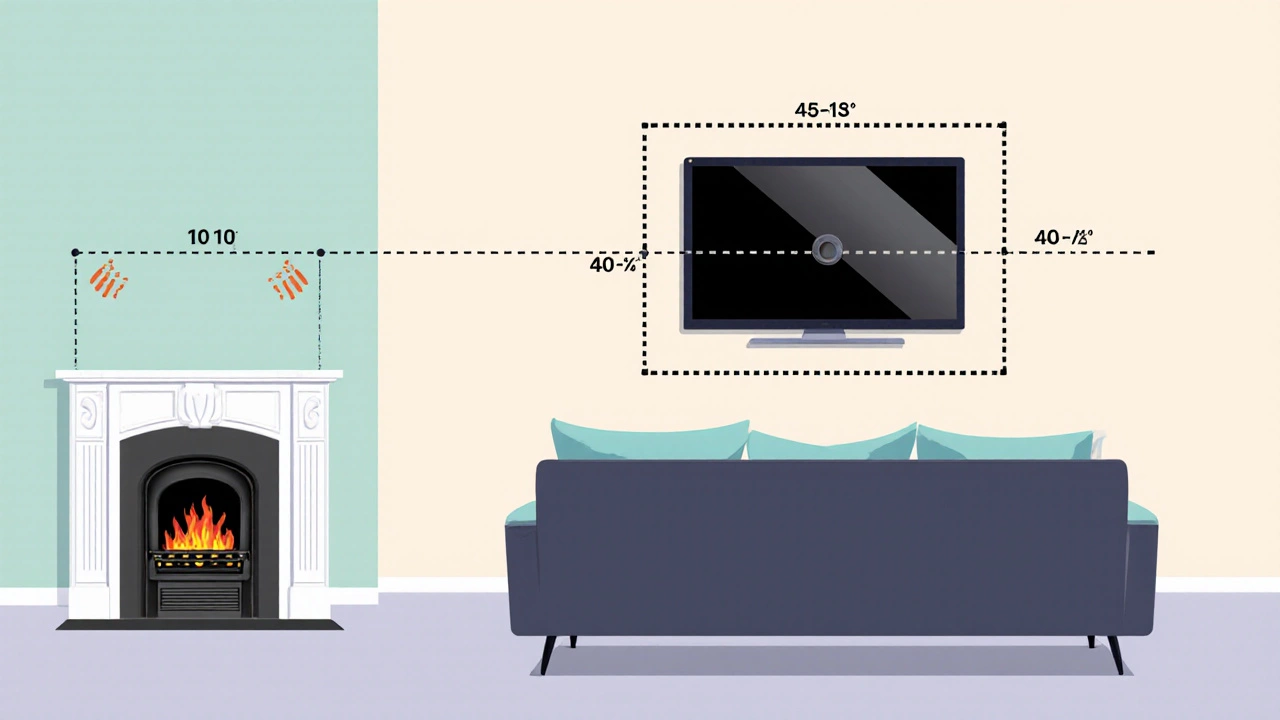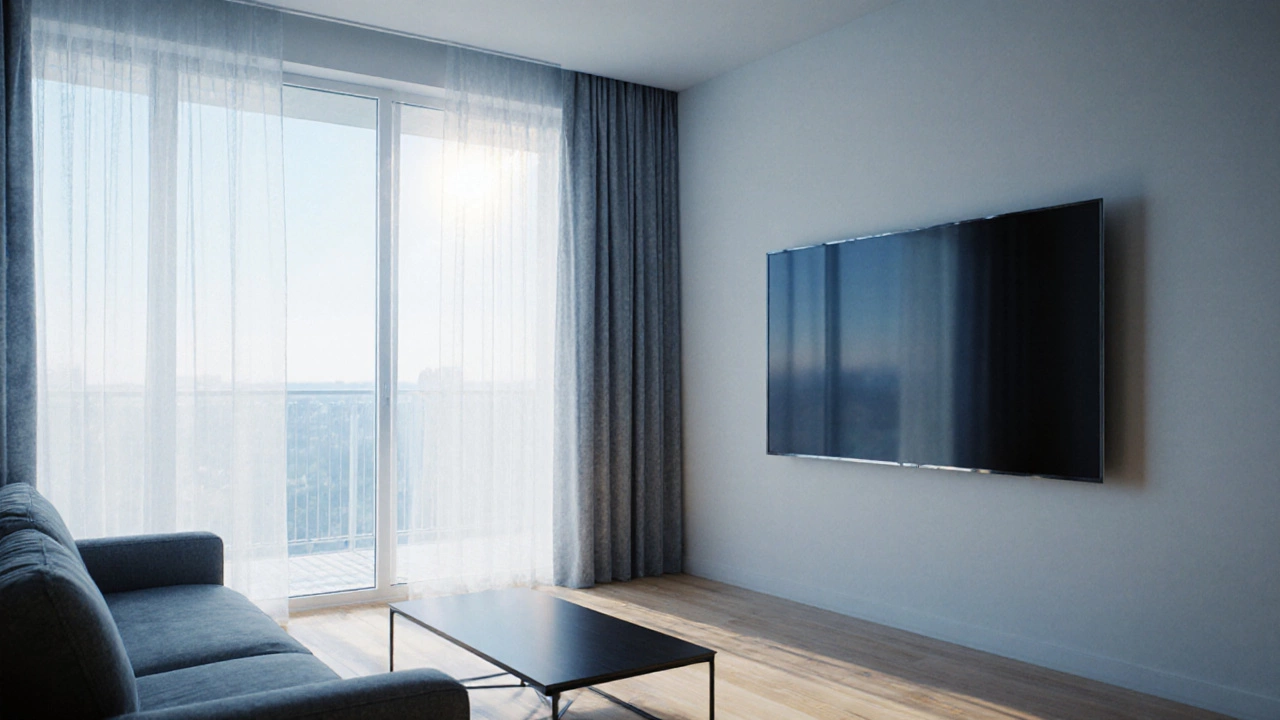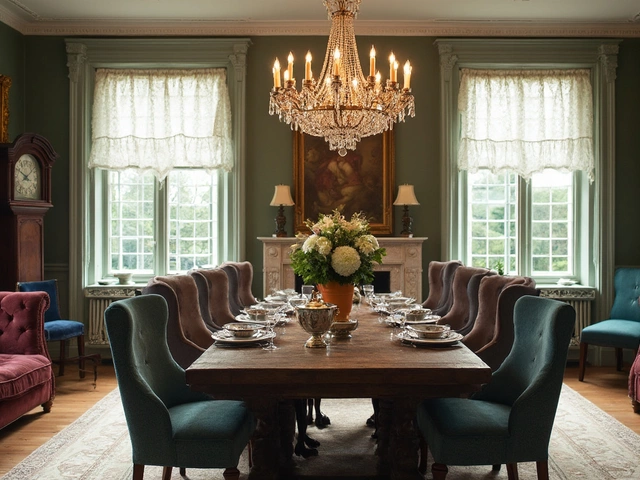TV Viewing Distance Calculator
Calculate the optimal viewing distance for your TV based on screen size. The recommended range is 1.5 to 2.5 times the screen diagonal.
For the best viewing experience, sit between 1.5x to 2.5x the diagonal screen size. Too close causes pixelation, too far reduces immersion.
TV placement is a decision that affects everything from picture quality to room flow. A wrong spot can create glare, strain your neck, or even damage the set. Below we walk through the places you should avoid, why they’re troublemakers, and how to fix common oversights without turning your living room into a tech‑free gallery.
Sunlight and Glare: The Biggest Enemy of a Clear Picture
Most folks love natural light, but when the sun beams directly onto the screen, the image looks washed out. The sunlight that streams through large windows is bright enough to drown out deep blacks and muted colors. If your TV lives opposite a south‑facing window, you’ll spend most evenings tweaking brightness or fighting with the TV’s HDR settings.
To keep glare at bay, aim for a wall that’s either shaded or faces away from the strongest light source. If you can’t move the TV, consider blackout curtains, low‑E glass, or an anti‑glare screen filter.
Viewing Angle: Don’t Sit at the Edge of the Screen
The human eye prefers to look at a screen straight on. A viewing angle that’s too wide will make colors shift and cause uneven brightness. This is why most manufacturers quote a “30‑degree vertical” and “40‑degree horizontal” optimal range.
Place the couch so the center of the TV is roughly at eye level when seated, and keep the distance about 1.5 to 2.5 times the diagonal size of the screen. Too close, and you’ll see pixelation; too far, and you’ll miss the immersive feel.
Humidity and Heat: Keep the TV Away from Moisture‑Rich Zones
Electronics hate excess humidity. Bathrooms, kitchens, and even overly damp basements can cause internal condensation, leading to short circuits over time.
Similarly, a TV positioned directly above a stove, fireplace, or radiators will endure constant temperature swings. The heat can warp plastic components and reduce the lifespan of internal capacitors. Give the set a breathing room of at least 12 inches from any heat source.
Acoustic Considerations: Sound Gets Trapped Too
Placing a TV on a wall made of dense material (like concrete) can reflect sound back into the room, creating echoey dialogue. The acoustics of the space matter more than you think, especially if you rely on the TV’s built‑in speakers.
Mount the screen on a slightly porous wall (drywall with a wooden backing) or add soft furnishings-rugs, curtains, upholstered chairs-to absorb excess reverberation.

Wall Type and Structural Safety: Not Every Wall Can Hold a Heavy Set
A wall that looks solid might actually be a plaster over drywall, which can’t safely support a 70‑inch TV and its mount. Before drilling, locate studs or use a wall anchor rated for the TV’s weight. Failing to do so can lead to a nasty fall.
Wall Art vs. TV: Avoid the Visual Tug‑of‑War
When a TV shares a wall with a favorite piece of wall art, the visual balance suffers. A large screen tends to dominate the eye, making nearby artwork feel secondary or even invisible.
If you love both, consider a dedicated media wall separate from the gallery wall, or use a slim, low‑profile mount that lets the TV sit close to the wall, reducing its visual bulk.
Wiring and Cable Management: Hide the Mess Before It Becomes a Trip Hazard
Nothing ruins a sleek living room faster than a tangled jungle of cords. The wiring should be routed through wall conduits or concealed behind a decorative trim. If you cannot hide cables, use a cable organizer box and keep the bundle away from high‑traffic walkways.

Furniture Layout: Keep Pathways Clear and Seating Comfortable
Positioning the TV too low or too high can force viewers to hunch or crane their necks. Also, avoid putting the TV where a coffee table or ottoman will block the view when people move around. Think of the room as a flowchart: entry points, seating zones, and the TV should sit at the intersection of clear sightlines and comfortable distance.
Common Mistakes vs. Best Practices
| Mistake | Why It Hurts | Better Choice |
|---|---|---|
| Directly opposite a large window | Creates glare, washes out colors | Mount on a shaded wall or use curtains |
| Too low on a bookcase | Neck strain, limited viewing angle | Mount at eye level (about 42‑48 inches from floor) |
| Above a fireplace | Heat damage, visual distortion | Leave at least 12‑in clearance or choose a side wall |
| Near a humid bathroom | Moisture can corrode internal parts | Keep TV at least 6 feet away from high‑humidity zones |
| Sharing a wall with large artwork | Cluttered visual hierarchy | Separate media wall or use a low‑profile mount |
Quick Checklist Before You Drill
- Identify stud locations; ensure the mount is rated for TV weight.
- Check for direct sunlight; add curtains or relocate if needed.
- Measure viewing distance: 1.5‑2.5 × screen diagonal.
- Confirm the wall isn’t exposed to excess humidity or heat.
- Plan cable routes; use conduit or in‑wall kits.
- Leave enough space for audio; consider external speakers if wall dampens sound.
- Ensure the TV doesn’t compete with existing wall art or décor.
Frequently Asked Questions
Can I mount a TV on a plaster wall?
Only if you locate the studs behind the plaster and use a mount rated for the combined weight of the TV and bracket. Otherwise, install a backing board or switch to a drywall anchor designed for heavy loads.
Is it okay to place a TV above a fireplace?
It’s not ideal. Heat can shorten the TV’s life and cause image distortion. If you must, keep at least a 12‑inch gap and use a heat‑shield pad.
What’s the best height for a TV on a wall?
Eye level when seated is the sweet spot-roughly 42‑48 inches from the floor to the screen’s center for most adults.
Do I need a special mount for a curved TV?
Yes. Curved screens exert lateral forces; a mount labeled for curved panels ensures a secure fit.
How can I hide cables without opening the wall?
Use paint‑on raceways or decorative trunking that match your wall color. They’re easy to install and remove.
By steering clear of the spots listed above, you’ll enjoy a crystal‑clear picture, comfortable viewing, and a living room that feels intentional rather than an after‑thought. Remember: the best TV placement blends function with style, so you get the most out of both your entertainment and your décor.








